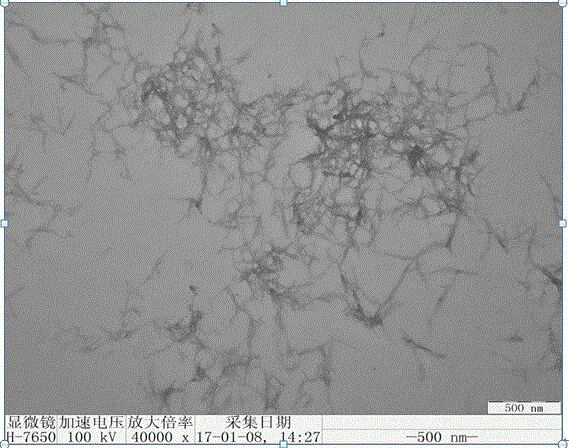Method for preparing nano-crystalline cellulose by multi-site oxidation method, and application thereof
A technology of nanocellulose and oxidation method, applied in the field of cellulose, can solve the problems of difficult recovery, expensive enzyme price, low reaction efficiency, etc., to reduce energy consumption and production cost, save the mechanical defibration step, and the process is simple. Easy to operate effect
- Summary
- Abstract
- Description
- Claims
- Application Information
AI Technical Summary
Problems solved by technology
Method used
Image
Examples
Embodiment 1
[0031] Add 500 ml of distilled water to a 1L beaker and wrap aluminum foil around it, add 2.5 mmol TEMPO, 40 mmol NaBr, 10 mmol NaIO 4 Add to beaker, also top with aluminum foil, and stir vigorously with a magnetic stirrer for 5 minutes. Remove the upper aluminum foil of the beaker, and add 5 g of commercial microcrystalline cellulose into the beaker while the magnetic stirrer is continuously stirring. After stirring evenly, 40 mmol of NaClO was slowly added. The stirring reaction was continued for 9 hours. During the reaction period, the pH value was adjusted once every 1.5 hours with 2M NaOH, so that the pH value of the reaction solution was maintained at about 10.5. After reacting for 9 hours, 5 mL of absolute ethanol was added to terminate the reaction, and the reaction time was 10 minutes. The reaction solution was centrifuged at 3000 rpm for 2 minutes, and the supernatant was precipitated with absolute ethanol at a volume ratio of 1:1.2, and then centrifuged. The pre...
Embodiment 2
[0033] Except that the reaction time is 4 hours, the rest of the operation method is the same as in Example 1, and nanocellulose with a rod-like shape observed by electron microscopy can also be obtained.
Embodiment 3
[0035] Nanocellulose was prepared from ordinary wood pulp. The hemicellulose and lignin in the wood pulp are first removed by general methods. Use glacial acetic acid and sodium chlorite to remove lignin, and use potassium hydroxide to remove hemicellulose to obtain purified cellulose. The following operation method is the same as in Example 1, and the shape of rod-shaped nanofibers observed by electron microscopy can be obtained. elements, but there are more network structures (such as figure 2 ).
PUM
| Property | Measurement | Unit |
|---|---|---|
| size | aaaaa | aaaaa |
| diameter | aaaaa | aaaaa |
Abstract
Description
Claims
Application Information
 Login to View More
Login to View More - R&D
- Intellectual Property
- Life Sciences
- Materials
- Tech Scout
- Unparalleled Data Quality
- Higher Quality Content
- 60% Fewer Hallucinations
Browse by: Latest US Patents, China's latest patents, Technical Efficacy Thesaurus, Application Domain, Technology Topic, Popular Technical Reports.
© 2025 PatSnap. All rights reserved.Legal|Privacy policy|Modern Slavery Act Transparency Statement|Sitemap|About US| Contact US: help@patsnap.com


